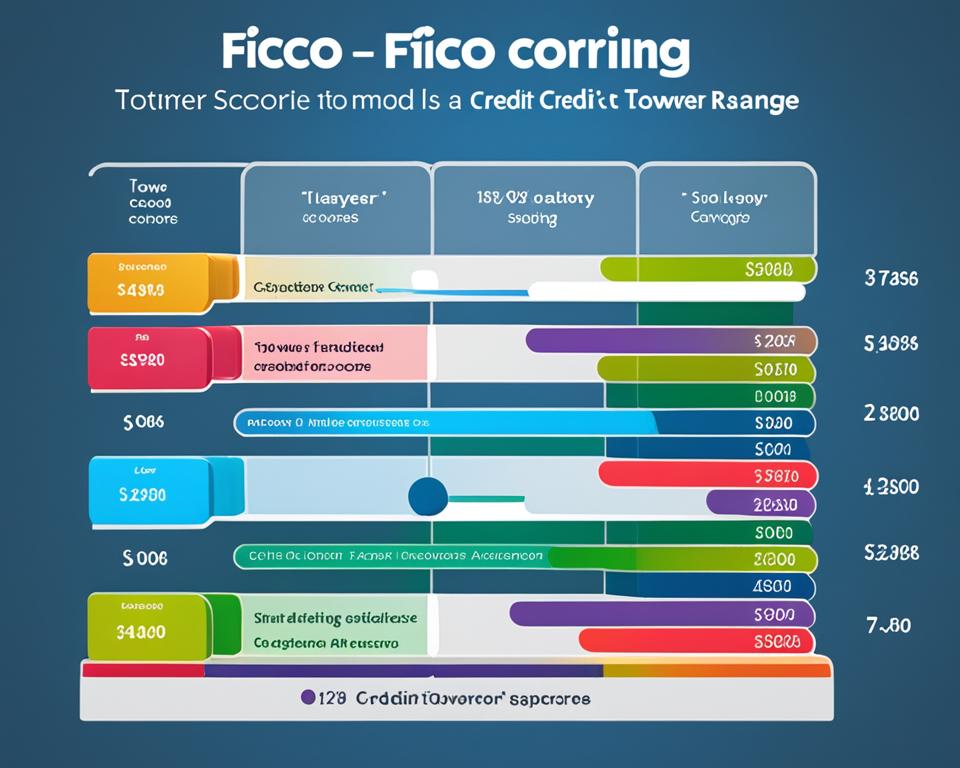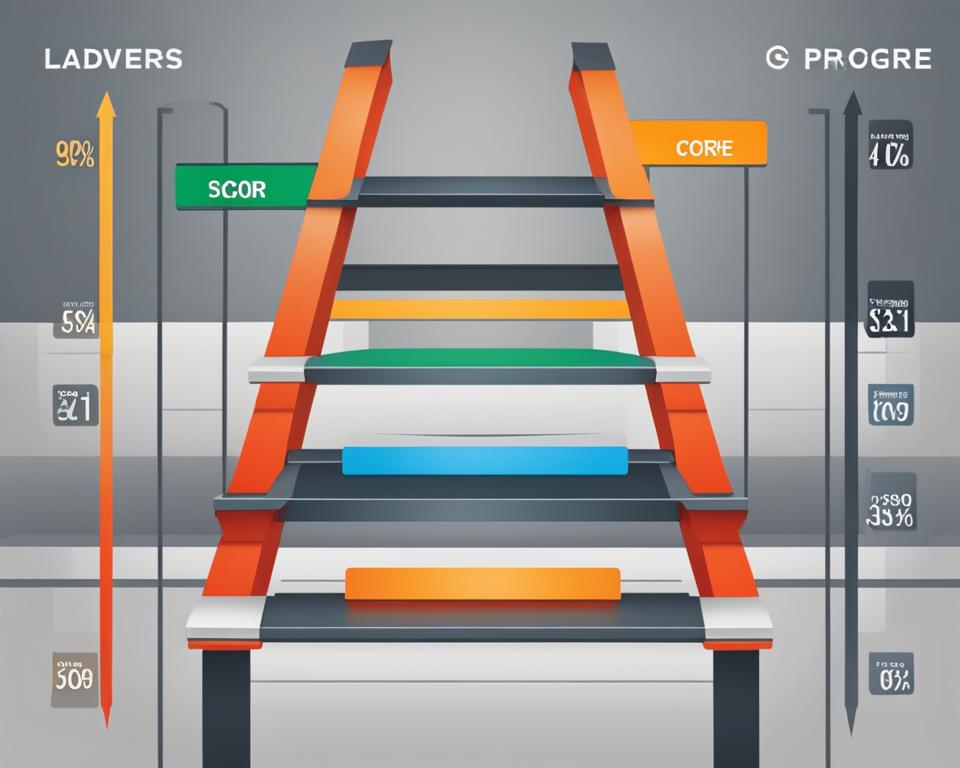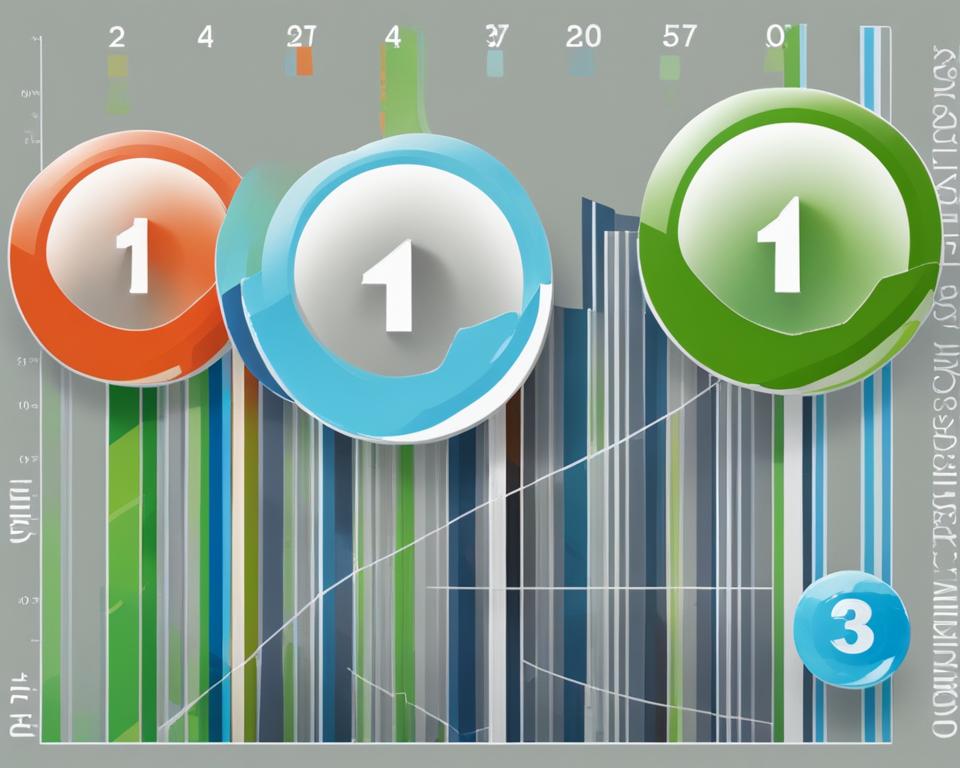When it comes to securing credit, understanding the importance of your credit score is crucial. But with so many credit scoring models out there, it can be confusing to figure out which score matters the most. In this article, we will delve into the world of credit scores and uncover the best credit score for lenders. So, let’s dive in and discover how you can maximize your credit scores to achieve your financial goals.
Key Takeaways:
- The FICO score is the most recognized and widely used credit scoring model.
- There are different versions of the FICO score that lenders may utilize.
- Other credit scoring models, such as VantageScore, Community Empower score, and credit bureau scores, may also impact your creditworthiness.
- FICO Scores are calculated based on factors such as payment history, credit utilization, credit history, credit use, and new credit.
- Choosing FICO Scores can give you the best chance of securing credit approval and favorable terms.
What Is a Credit Scoring Model?
Credit scoring models are statistical analyses used by credit bureaus to evaluate an individual’s creditworthiness when applying for credit. These models are designed to assess the risk associated with lending money to a particular individual. By using statistical analysis, credit bureaus can predict the likelihood of a borrower repaying their debt based on historical data and patterns.
In a credit scoring model, credit bureaus select statistical characteristics found in a person’s credit payment patterns and analyze them to determine an individual’s creditworthiness. Factors such as payment record, frequency of payments, amount of debts, credit charge-offs, and number of credit cards held are taken into account in the scoring calculations. Each of these factors is assigned a weight in the model’s formula, and a credit score is generated based on the evaluation.
A credit scoring model is a comprehensive and objective way to assess an individual’s creditworthiness. By using statistical analysis and historical data, credit bureaus can make informed decisions about an individual’s likelihood of repaying their debts. This allows lenders to evaluate risk accurately and make fair lending decisions.
In summary, a credit scoring model is a powerful tool that utilizes statistical analysis to evaluate an individual’s creditworthiness. By considering various factors and assigning them weights, credit bureaus can generate a credit score that helps lenders make informed decisions about granting credit.
FICO Scoring Model
The FICO scoring model is widely recognized as the most reliable credit scoring model in the industry. It is trusted by about 90% of lenders to evaluate candidates for credit. FICO has continuously revised its scoring model over the years to adapt to changing factors and improve accuracy.
The latest version of the FICO scoring model is FICO 10, which was introduced in 2021. However, one of the most significant changes to the model came with the release of FICO 9 in 2014. FICO 9 introduced several updates to enhance credit score reliability.
One notable change in FICO 9 was the decrease in the weight given to unpaid medical bills, recognizing that medical debt can sometimes be beyond an individual’s control. Additionally, rental history was included in credit history, providing a more comprehensive view of an individual’s financial behavior.
By constantly refining its scoring model, FICO aims to ensure that credit scores accurately reflect an individual’s creditworthiness, helping lenders make informed lending decisions.

How Are FICO Scores Calculated?
FICO Scores, widely used by lenders to evaluate creditworthiness, are calculated using five key factors. These factors include:
- Payment History: Accounting for 35% of the score, payment history reflects an individual’s track record of making timely payments on credit accounts.
- Credit Utilization: This factor contributes 30% to the score and considers the amount of available credit that an individual utilizes. Lower credit utilization generally indicates responsible credit management.
- Credit History: Accountable for 15% of the score, credit history reflects the length of time a person has had credit accounts open and the age of their oldest account.
- Credit Use: Contributing 10% to the score, credit use relates to the mix of credit types an individual has, such as credit cards, auto loans, and mortgages.
- New Credit: This factor also accounts for 10% of the score and looks at recent credit inquiries and the number of new accounts opened, indicating potential risk.
By evaluating these factors, FICO Scores aim to provide a comprehensive assessment of an individual’s creditworthiness and likelihood to repay debts.
Vantage Score Model
The VantageScore model was introduced as a competition to the FICO score, offering a different approach to credit scoring. Developed by the three major credit bureaus – Experian, Equifax, and TransUnion – the VantageScore model takes into account various credit score components to provide lenders with a comprehensive view of an individual’s creditworthiness.
The VantageScore model considers factors such as payment history, length of credit history, credit utilization, total balances, recent behavior, and available credit. Each of these components plays a significant role in determining a person’s credit score.
In 2017, the VantageScore model underwent scoring changes to provide a more accurate and inclusive credit evaluation. One notable change was the inclusion of trended data, which analyzes an individual’s credit behavior over time rather than focusing solely on a snapshot of their current credit situation. This addition allows lenders to assess creditworthiness more effectively and make informed lending decisions.
Furthermore, the VantageScore model provides relief for accounts affected by natural disasters. This means that individuals experiencing financial hardships due to natural calamities, such as hurricanes or wildfires, are not unfairly penalized in their credit scores. This feature demonstrates the model’s commitment to fairness and compassion in evaluating creditworthiness.
The VantageScore model has emerged as a strong competitor to the FICO score, offering an alternative perspective in credit scoring. By considering a broader range of credit score components and incorporating changes to adapt to evolving credit landscapes, the VantageScore model aims to provide a comprehensive assessment of an individual’s creditworthiness.

| Criteria | VantageScore Model | FICO Score |
|---|---|---|
| Credit Utilization | Considers credit utilization ratio and available credit limits | Also evaluates credit utilization, but with slightly different parameters |
| Payment History | Weighs on-time payments and payment patterns | Similar focus on payment history, although calculations may differ |
| Length of Credit History | Considers the duration of credit accounts | Also takes into account the length of credit history |
| Total Balances | Evaluates the total amount owed across different credit accounts | Similar consideration given to total outstanding balances |
| Recent Behavior | Examines recent credit activities and fluctuations | Also analyzes recent credit behavior and fluctuations |
Other Credit Scoring Models
In addition to FICO and VantageScore, there are other credit scoring models that lenders use to assess creditworthiness. Two notable examples are the TransRisk score and Experian’s National Equivalency Score.
The TransRisk score is a credit model developed by TransUnion, one of the major credit reporting bureaus. It considers various factors such as payment history, credit utilization, length of credit history, and public records to calculate an individual’s credit score. This model helps lenders evaluate credit risk and make informed lending decisions.
Experian’s National Equivalency Score, on the other hand, is a credit scoring model developed by Experian, another leading credit reporting agency. This score provides lenders with a holistic view of an individual’s creditworthiness by analyzing factors such as payment history, credit utilization, length of credit history, and public records. The National Equivalency Score enables lenders to assess credit risk and determine appropriate lending terms.
These credit scoring models, like all credit scores, are designed to help lenders evaluate the creditworthiness of individuals. While FICO and VantageScore are widely used and recognized, the TransRisk score and Experian’s National Equivalency Score offer alternative perspectives on creditworthiness for lenders to consider.
It’s important to note that these alternative credit scoring models may not be as widely used as FICO and VantageScore. Lenders often rely on the FICO score due to its long-standing reputation and consistency in predicting credit risk. However, the TransRisk score and Experian’s National Equivalency Score provide additional insights and may be used by certain lenders to make more informed lending decisions.
Comparison of Credit Scoring Models
| Credit Scoring Model | Key Factors Considered | Usage by Lenders |
|---|---|---|
| FICO | Payment history, credit utilization, length of credit history, credit mix, new credit | Widely used by 90% of lenders |
| VantageScore | Payment history, credit utilization, credit age and mix, total balances, new credit | Increasing adoption by lenders |
| TransRisk | Payment history, credit utilization, length of credit history, public records | Less widely used than FICO and VantageScore |
| Experian’s National Equivalency Score | Payment history, credit utilization, length of credit history, public records | Used by select lenders for additional insights |
Understanding these various credit scoring models can help consumers gain insights into their creditworthiness and make informed financial decisions. While FICO Scores remain the most widely recognized and used, alternative models like the TransRisk score and Experian’s National Equivalency Score offer additional perspectives that lenders may consider.
Not All Credit Scores Are FICO Scores
When it comes to credit scores, not all are created equal. While FICO Scores have been the industry standard for over 25 years, there are other credit scoring models in the market. FICO Scores, developed by the Fair Isaac Company, are widely recognized and trusted by lenders when evaluating credit risk. Many lenders rely on FICO Scores to make informed lending decisions.
However, other credit scoring models exist, and they may provide different results compared to FICO Scores. These alternative credit scores can vary by as much as 100 points, which could have a significant impact on creditworthiness assessments.
Understanding the differences between FICO Scores and other credit scores is crucial for borrowers seeking credit and financial institutions making lending decisions.
Take a look at the table below for a quick comparison:
| Credit Scoring Model | Usage | Score Variation |
|---|---|---|
| FICO Scores | Widely used by lenders | Consistent |
| Other Credit Scores | Used by some lenders | May vary by up to 100 points |
As you can see, while FICO Scores are the preferred choice for most lenders, some institutions may use alternative credit scoring models. Therefore, it’s essential to be familiar with the credit scoring model used by the lender you’re applying to, as it can significantly impact your creditworthiness assessment.

Why Do FICO Scores Matter?
FICO Scores play a crucial role in the world of credit, impacting lending decisions, loan approvals, interest rates, and terms. Lenders rely on FICO Scores as a reliable measure of an individual’s creditworthiness, helping them assess the likelihood of timely loan repayments. By using FICO Scores, lenders can make consistent lending decisions and manage risk effectively, while borrowers gain fair and expedited access to credit.
When applying for credit, whether it’s a mortgage, auto loan, or credit card, lenders often consider the applicant’s FICO Score as a primary factor. This three-digit number provides valuable insight into an individual’s financial responsibility and reliability. Lenders can assess the level of risk associated with each potential borrower and make more informed lending decisions based on their FICO Score.
FICO Scores are calculated based on various factors, including payment history, credit utilization, credit history, credit use, and new credit. These factors are carefully evaluated to determine an individual’s creditworthiness, ensuring that lending decisions are fair, consistent, and objective.
“Lenders rely on FICO Scores as a reliable measure of an individual’s creditworthiness, helping them assess the likelihood of timely loan repayments.”
By using FICO Scores, lenders can minimize risks associated with lending to individuals with poor credit history or a high likelihood of default. This enables lenders to provide credit to a wider range of borrowers while ensuring the overall stability of the lending ecosystem.
Additionally, FICO Scores offer borrowers faster access to credit. Lenders can quickly assess an applicant’s creditworthiness and make faster approval decisions, streamlining the borrowing process. Fair access to credit is vital for individuals and businesses alike, allowing them to seize opportunities, meet financial obligations, and achieve their goals.
Whether it’s securing a home loan, financing a car, or obtaining a credit card, a good FICO Score opens up possibilities for individuals and helps them achieve their financial aspirations. With FICO Scores serving as a trusted and widely accepted credit evaluation tool, borrowers can navigate the credit landscape with confidence and make informed financial decisions.
Top 3 Reasons to Choose FICO Scores
When it comes to credit scores, FICO Scores have numerous advantages over other credit scoring models. Lenders across the country trust FICO Scores for their accuracy and reliability, making them the preferred choice for assessing creditworthiness. If you’re wondering why FICO Scores are worth considering, here are the top three reasons:
1. Widely Accepted by Lenders
FICO Scores are used by a vast majority of lenders, providing you with the assurance that your scores will be thoroughly evaluated when you apply for credit. Over 90% of the top lenders rely on FICO Scores to make lending decisions, giving you better access to credit opportunities.
2. Informed Financial Decisions
By choosing FICO Scores, you gain a comprehensive understanding of your creditworthiness based on the same scores used by the majority of lenders. This empowers you to make informed financial decisions and take control of your credit health. With FICO Scores, you can confidently assess your eligibility for loans, credit cards, and other financial products.
3. Consistency and Accuracy
Non-FICO credit scores can differ significantly from FICO Scores, which can lead to an overestimation or underestimation of your creditworthiness. FICO Scores are designed to provide consistent and reliable evaluations, ensuring fair lending practices. By choosing FICO Scores, you can trust that your creditworthiness will be accurately assessed, giving you a clearer picture of your financial standing.
When it comes to credit scores, choosing FICO Scores offers distinct benefits. Their widespread acceptance among lenders, ability to make informed financial decisions, and accuracy in evaluating creditworthiness set them apart from other credit scoring models. With FICO Scores, you can confidently navigate the world of credit and make informed financial choices for a brighter financial future.
Perfect Score vs. Average Score: Credit Profiles
People with perfect credit scores have distinct credit profiles compared to those with average scores. Understanding these differences can provide valuable insights into debt management and the characteristics of a perfect credit score.
Individuals with perfect scores tend to have a higher number of tradelines and credit cards compared to those with average scores. This indicates a consistent and responsible credit history, as lenders see multiple credit accounts as evidence of good credit management.
However, despite having more credit accounts, individuals with perfect scores typically owe less on average. Their ability to manage debt effectively reflects positively on their credit profile.
It’s important to note that while individuals with perfect scores excel in many credit categories, they may have higher amounts of debt in certain types of credit, such as personal loans. This suggests that perfect credit does not necessarily imply complete debt-free status, but rather a balanced and responsible approach to credit utilization.
To summarize, individuals with perfect credit scores exhibit a credit profile characterized by a higher number of credit accounts, low overall debt, and responsible debt management. Understanding these characteristics can help inform individuals looking to improve their credit and strive towards achieving a perfect credit score.
Which Generation Is Most Likely to Have a Perfect FICO Score?
The majority of consumers with perfect FICO Scores are of the older generations, baby boomers, and the silent generation. Younger generations, like Generation X, millennials, and Generation Z, are less likely to have perfect scores. Length of credit history is a factor in determining credit scores, and older generations have had more time to establish longer credit histories.
Having a perfect FICO Score is a rare achievement, and older generations seem to have a higher likelihood of reaching this credit milestone. This can be attributed to several factors, including the length of time they have been using credit and their financial habits and responsibilities.
With longer credit histories, older generations have had more opportunities to prove their creditworthiness and demonstrate consistent payment behavior. This has a positive impact on their credit scores, increasing the likelihood of reaching the coveted perfect score of 850.
On the other hand, younger generations have had less time to establish credit histories and may still be in the process of building their financial profiles. They may have limited credit accounts and shorter payment histories, which can impact their credit scores.
It’s important to note that while older generations may have a higher proportion of individuals with perfect scores, it doesn’t mean that all members of these generations have perfect scores. Credit scores vary among individuals, regardless of generation, depending on factors such as credit utilization, payment history, and the types of credit accounts held.
Ultimately, maintaining a good credit score is important for individuals of all generations. A good score can open doors to better borrowing opportunities, lower interest rates, and improved financial stability.
Generational Comparison of Credit Scores
The table below provides a comparison of credit scores by generation, highlighting the variations in average credit scores:
| Generation | Average Credit Score |
|---|---|
| Baby Boomers | 720 |
| Generation X | 680 |
| Millennials | 640 |
| Generation Z | 620 |
These numbers reflect the average credit scores for each generation and serve as a general guide. It’s important to remember that individual credit scores can vary significantly within each generation based on personal financial behaviors and circumstances.
While older generations may have higher average credit scores, younger generations have the opportunity to improve their scores over time with responsible credit management and financial habits.
So, while older generations may be more likely to have perfect FICO Scores, creditworthiness can be achieved by individuals of all ages by establishing and maintaining a positive credit history.
| State | Percentage of Residents with Perfect FICO Scores |
|---|---|
| Hawaii | 2% |
| Minnesota | 1.9% |
| Washington | 1.9% |
| Oregon | 1.8% |
| Wisconsin | 1.8% |
| Maine | 1.8% |
In the United States, Hawaii has the highest concentration of people with perfect FICO Scores. Approximately 2% of residents in Hawaii have a credit score of 850, which is the highest possible score. This indicates a high level of financial responsibility and may be attributed to the demographic of retirees who relocate to Hawaii, seeking a certain level of financial security in their golden years.
Having a perfect credit score of 850 demonstrates excellent credit management and opens doors to various financial opportunities, such as favorable interest rates, higher credit limits, and better loan terms. It showcases a solid payment history, low credit utilization, and a lengthy credit history.
While Hawaii takes the lead in terms of the highest percentage of residents with perfect credit scores, other states also boast impressive percentages. Minnesota and Washington both have 1.9% of residents with perfect FICO Scores, followed closely by Oregon, Wisconsin, and Maine, each with 1.8% of residents achieving the perfect credit score.
It’s important to note that having a perfect FICO Score is not a requirement for financial success. Responsible financial habits, a good credit score, and proper debt management are more important than striving for perfection. Aiming for a high credit score and maintaining a healthy credit profile will provide stability and open doors to better financial opportunities.

Is achieving a perfect credit score necessary?
“While having a perfect credit score is a significant achievement, it’s not a prerequisite for financial success. Lenders evaluate creditworthiness based on a range of factors, including payment history, credit utilization, and length of credit history. A good credit score, even if not perfect, can still qualify you for favorable financial terms.”
Understanding credit scores and working towards maintaining a healthy credit profile should be the primary focus. Regularly checking credit reports, paying bills on time, keeping credit card balances low, and minimizing new credit applications are all important steps in achieving financial security and accessing the best lending opportunities available.
Among Metro Areas, Look to the Golden State for Perfection
When it comes to metro areas with perfect credit scores, California proves to be a shining example. With its diverse and thriving communities, the state boasts some of the highest percentages of perfect credit scores in its metropolitan statistical areas (MSAs). These areas include both smaller, affluent enclaves and larger metros like the San Francisco-Oakland MSA.
In these California MSAs, residents demonstrate exceptional financial responsibility and creditworthiness, reflecting the importance placed on maintaining a solid credit profile in this region. The high concentration of individuals with perfect credit scores highlights the state’s commitment to fiscal well-being and responsible debt management.
While California leads the way in credit excellence, other metro areas across the country also stand out for their impressive number of perfect credit scorers. Notable examples include Honolulu, Corvallis, Minneapolis, and Washington, D.C. These areas are home to individuals who have diligently managed their credit and maintained exemplary financial standing.
California Metro Areas with Perfect Credit Scores
| Metro Area | Percentage of Population with Perfect Credit Scores |
|---|---|
| San Francisco-Oakland-Hayward, CA | 3.5% |
| San Jose-Sunnyvale-Santa Clara, CA | 2.9% |
| San Diego-Carlsbad, CA | 2.6% |
| Los Angeles-Long Beach-Anaheim, CA | 2.1% |
| Santa Rosa, CA | 1.9% |
| Santa Cruz-Watsonville, CA | 1.8% |
| Oxnard-Thousand Oaks-Ventura, CA | 1.6% |
As seen in the table above, several metro areas within California have impressively high percentages of their populations boasting perfect credit scores. These numbers reflect the dedication and financial responsibility exhibited by residents in maintaining excellent credit profiles.
It is worth noting that while California’s metro areas lead in terms of perfect credit scores, other states and communities also have individuals who excel in managing their credit and achieving high credit scores. Whether it’s in the vibrant cities of Hawaii, the tranquil college town of Corvallis, or the bustling metropolises like Minneapolis and Washington, D.C., individuals across the country are committed to financial success and creditworthiness.
By examining these metro areas with perfect credit scores, we can learn valuable insights about the characteristics and behaviors that contribute to achieving and maintaining exceptional credit profiles. These areas serve as inspiring examples for individuals across the country striving to improve their creditworthiness and secure a bright financial future.
Conclusion
In conclusion, credit scores are incredibly important when it comes to determining creditworthiness and influencing lending decisions. Lenders rely heavily on credit scores to assess an individual’s ability to repay loans and determine favorable borrowing terms and interest rates. Among the various credit scoring models, FICO Scores are widely recognized and trusted by lenders across the United States.
While there are other credit scoring models available, it’s important to note that they may differ significantly from FICO Scores. Understanding how your credit score is calculated and striving for a good credit score is crucial to ensure favorable lending outcomes.
To maximize your credit score, it is important to maintain a positive payment history, keep credit utilization low, establish a good credit history, and manage new credit responsibly. By doing so, you can improve your creditworthiness and have access to the best borrowing terms and rates.
FAQ
Which credit score matters the most?
The most recognized credit score is the FICO score, which is used by about 90% of lenders. However, there are other credit scoring models like VantageScore, TransRisk, and Experian’s National Equivalency Score that are used by different lenders and may vary in their evaluation of creditworthiness.
What is a credit scoring model?
A credit scoring model is a statistical analysis used by credit bureaus to evaluate a person’s creditworthiness. These models consider factors such as payment history, credit utilization, credit history, credit use, and new credit, and assign a credit score based on the evaluation.
How are FICO Scores calculated?
FICO Scores are calculated using five base factors: payment history, credit utilization, credit history, credit use, and new credit. Each factor is assigned a weight in the scoring model’s formula, with payment history and credit utilization carrying the most significant weight.
What is the VantageScore model?
The VantageScore model is a credit scoring model introduced as competition to the FICO score. It considers factors such as payment history, length of credit history, credit utilization, total balances, recent behavior, and available credit to determine a person’s creditworthiness.
Are there other credit scoring models besides FICO and VantageScore?
Yes, besides FICO and VantageScore, there are other credit scoring models such as TransRisk and Experian’s National Equivalency Score. These models utilize different data and factors to calculate credit scores, but they are not as widely used as FICO and VantageScore.
Are all credit scores FICO Scores?
No, not all credit scores are FICO Scores. FICO Scores are the industry standard and widely used by lenders, but there are other credit scores that can be different from FICO Scores and may vary by as much as 100 points.
Why do FICO Scores matter?
FICO Scores matter because many lenders use them to make decisions about credit approvals, terms, and interest rates. By using FICO Scores, lenders can assess a person’s likelihood to repay their loan on time and take on less risk. Borrowers with higher FICO Scores also have faster and fairer access to credit.
What are the top reasons to choose FICO Scores over other credit scores?
There are several reasons to choose FICO Scores over other credit scores. Firstly, many lenders use FICO Scores, so by choosing FICO Scores, you can be confident that the lender will check your scores when you apply for credit. Secondly, FICO Scores provide you with the scores used by 90% of the top lenders, helping you make more informed financial decisions. Lastly, non-FICO credit scores can differ significantly from FICO Scores, leading to overestimation or underestimation of creditworthiness.
How do credit profiles of people with perfect scores differ from those with average scores?
People with perfect credit scores tend to have more tradelines and credit cards but owe less on average. However, they may have more debt with types of credit like personal loans. People with average scores may have a mix of tradelines and credit cards, with varying levels of debt.
Which generation is most likely to have a perfect FICO score?
The majority of consumers with perfect FICO Scores are from the older generations, including baby boomers and the silent generation. Younger generations, like Generation X, millennials, and Generation Z, are less likely to have perfect scores due to their shorter credit histories.
Which state has the highest concentration of people with perfect FICO Scores?
Hawaii has the highest concentration of people with perfect FICO Scores compared to other states in the U.S., with 2% of residents having a score of 850. This may be attributed to the demographic of retirees who relocate to Hawaii, requiring a certain level of financial security.
Which metropolitan areas have the highest percentages of people with perfect credit scores?
Metropolitan statistical areas (MSAs) in California have some of the highest percentages of people with perfect credit scores. This includes both smaller, wealthy enclaves and larger metros like the San Francisco-Oakland MSA. Other standout metros include Honolulu, Corvallis, Minneapolis, and Washington, D.C.





